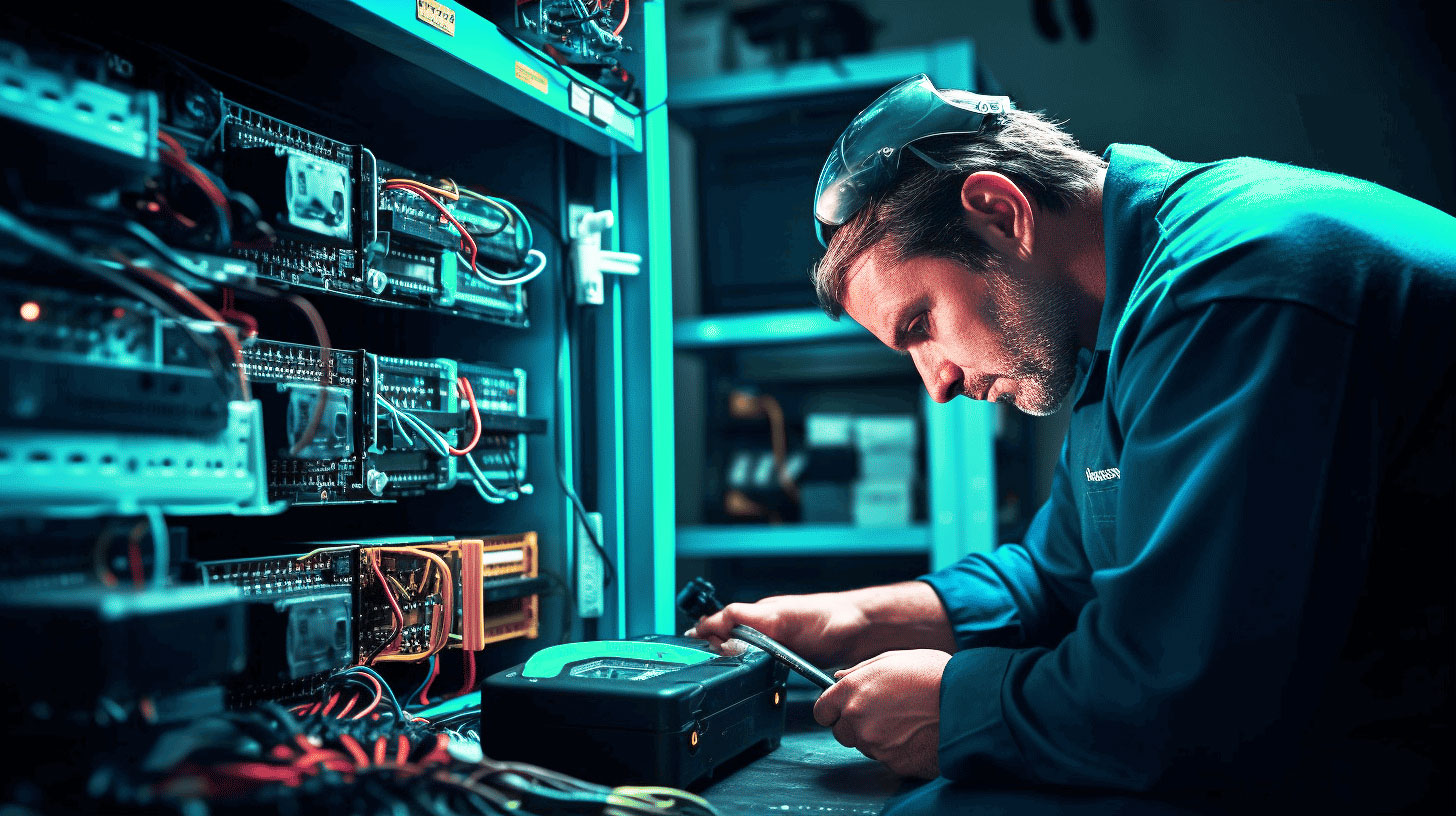Emergency UPS Repairs in the UK: What You Need to Know in 2025
In today’s fast-paced and technology-driven world, the reliability of power supply systems is more critical than ever. Uninterruptible Power Supply (UPS) systems play a pivotal role in ensuring that businesses, healthcare facilities, data centres, and other critical sectors remain operational during power disruptions. As we look ahead to 2025, the landscape of emergency repairs for UPS systems in the UK is evolving rapidly, driven by technological advancements, environmental considerations, and the increasing complexity of power demands.
In this article, we’ll explore the intricacies of UPS systems, their importance in the UK, and the challenges and best practices associated with emergency repairs. Whether you’re a facility manager, an IT professional, or simply someone interested in the future of power supply systems, this guide will provide valuable insights into how we can navigate the complexities of maintaining and repairing UPS systems in an ever-changing world. Let’s dive in and make sense of what lies ahead for emergency UPS repairs in the UK.

Understanding Uninterruptible Power Supply (UPS) Systems
In our technology-driven world, power interruptions can disrupt operations, damage equipment, and lead to significant downtime. That’s where Uninterruptible Power Supply (UPS) systems come into play. These systems are designed to provide backup power during outages, ensuring that critical devices and systems remain operational. Let’s dive deeper into what UPS systems are, their key components, and where they are commonly used.
What is a UPS system?
A UPS system is a device that provides emergency power to connected equipment when the main power source fails. Unlike generators, which take time to start, a UPS offers instantaneous power backup, ensuring there’s no interruption in operations. It acts as a bridge between the primary power source and the backup, giving users enough time to save data, shut down systems safely, or switch to an alternative power source.
UPS systems are not just about backup power; they also protect against power fluctuations, surges, and sags, which can harm sensitive electronics. Whether it’s a data centre, hospital, or even your home office, a UPS system is a reliable safeguard against unexpected power issues.
Key Components of a UPS System
A UPS system is made up of several critical components that work together to deliver uninterrupted power. Here’s a breakdown of the main parts:
- Battery: At the heart of the UPS system, the battery stores energy that is used during a power outage. Modern UPS systems often use lithium-ion batteries for their efficiency and longer lifespan.
- Inverter: This component converts the battery’s stored DC power into AC power, which is what most devices and equipment use.
- Rectifier/Charger: It converts incoming AC power into DC power to charge the battery and ensures the system is always ready for an outage.
- Static Switch: This allows the UPS to switch between power sources seamlessly, ensuring no disruption to connected devices.
- Control Panel: The interface that allows users to monitor and manage the UPS system, providing real-time information about power status, battery life, and more.
Each of these components plays a vital role in ensuring the UPS system operates efficiently and reliably.
Common Applications of UPS Systems
UPS systems are versatile and find applications across various industries and settings. Here are some of the most common uses:
- Data Centres: Protecting servers and IT infrastructure from power outages is critical to maintaining uptime and preventing data loss.
- Healthcare Facilities: Hospitals rely on UPS systems to keep life-saving medical equipment running during power failures.
- Telecommunications: Ensuring uninterrupted communication networks is essential, and UPS systems provide the necessary backup power.
- Industrial Settings: Manufacturing plants use UPS systems to protect machinery and prevent costly downtime.
- Home and Small Offices: For individuals and small businesses, a UPS system can safeguard computers, routers, and other essential devices.
In essence, UPS systems are indispensable in any environment where power continuity is critical. Whether you’re managing a large-scale operation or simply protecting your home office, understanding how these systems work can help you make informed decisions about your power backup needs.
By integrating a UPS system into your setup, you’re not just preparing for the unexpected—you’re ensuring peace of mind and uninterrupted productivity.
The Importance of UPS Systems in the UK
In today’s fast-paced and technology-driven world, uninterrupted power is no longer a luxury—it’s a necessity. Across the UK, businesses and critical sectors rely heavily on Uninterruptible Power Supply (UPS) systems to ensure seamless operations, protect sensitive equipment, and safeguard against the costly consequences of power outages. Whether it’s a hospital performing life-saving procedures, a data centre managing vast amounts of information, or a manufacturing plant operating precision machinery, the role of UPS systems cannot be overstated.
Reliance on UPS Systems in Critical Sectors
From healthcare to finance and from manufacturing to telecommunications, UPS systems are the backbone of operational continuity. In the healthcare sector, for instance, even a momentary power interruption can jeopardise patient safety, disrupt critical medical equipment, and compromise data integrity. Hospitals and clinics across the UK depend on UPS systems to maintain power during emergencies, ensuring that life-support systems, diagnostic tools, and electronic health records remain functional.
Similarly, data centres, which are the heart of the digital economy, rely on UPS systems to prevent downtime and data loss. With the UK’s increasing reliance on cloud computing and online services, any disruption in power can lead to significant financial losses and reputational damage. UPS systems act as a safety net, providing immediate backup power and allowing for a smooth transition to generators if needed.
In the manufacturing sector, where precision and timing are critical, power outages can result in production halts, equipment damage, and costly delays. UPS systems ensure that machinery continues to operate without interruption, protecting both productivity and profitability.
Impact of Power Outages on Businesses and Infrastructure
Power outages, whether caused by grid failures, severe weather, or technical faults, can have devastating effects on businesses and infrastructure. For many organisations, downtime isn’t just an inconvenience—it’s a direct threat to their bottom line. Studies show that even a few minutes of power loss can result in significant financial losses, particularly for industries that operate around the clock.
Beyond financial implications, power outages can also damage equipment, disrupt supply chains, and erode customer trust. In sectors like telecommunications and finance, where uptime is critical, the inability to maintain operations can lead to long-term reputational harm.
This is where UPS systems shine. By providing immediate backup power, they mitigate the risks associated with outages, ensuring that critical systems remain operational until normal power is restored. For businesses in the UK, investing in a reliable UPS system isn’t just about avoiding downtime—it’s about safeguarding their future.
As we continue to embrace digital transformation and technological advancements, the importance of UPS systems will only grow. They are not just a safeguard against power interruptions; they are a cornerstone of resilience in an increasingly interconnected world. By prioritising reliable power solutions, we can ensure that our businesses, infrastructure, and communities remain strong, no matter what challenges arise.
Common Issues with UPS Systems
When it comes to maintaining the reliability of your Uninterruptible Power Supply (UPS) systems, understanding the most common issues is crucial. These systems are designed to provide seamless power backup, but like any technology, they are not immune to problems. In our experience, certain issues tend to arise more frequently, often requiring emergency repairs. Let’s break down the top challenges we’ve encountered and how they can impact your operations.
Battery Failures
One of the most prevalent issues we see with UPS systems is battery failure. Batteries are the heart of any UPS, and their performance directly affects the system’s ability to provide backup power. Over time, batteries can degrade due to factors like age, improper maintenance, or extreme temperatures. Symptoms of battery failure include reduced runtime, frequent alarms, or the inability to hold a charge. Regular battery testing and timely replacements are essential to avoid unexpected downtime. For more insights on maintaining your UPS, check out our guide on UPS maintenance tips.
Overheating and Ventilation Problems
Another common issue is overheating, often caused by inadequate ventilation or high ambient temperatures. UPS systems generate heat during operation, and if this heat isn’t properly dissipated, it can lead to component failure or even system shutdowns. We recommend ensuring that your UPS is installed in a well-ventilated area and that airflow isn’t obstructed. Additionally, periodic cleaning of vents and fans can prevent dust buildup, which exacerbates overheating problems.
Software and Firmware Glitches
Modern UPS systems often come equipped with advanced software and firmware to monitor and manage performance. However, these systems are not immune to glitches or bugs. Outdated firmware, compatibility issues, or corrupted software can cause the UPS to malfunction or fail to communicate with connected devices. Regularly updating your UPS software and firmware can mitigate these risks. It’s also a good idea to test the system after updates to ensure everything is functioning as expected.
By staying proactive and addressing these common issues, you can significantly extend the lifespan of your UPS system and ensure it remains a reliable safeguard for your critical operations. Remember, prevention is always better than dealing with an emergency repair!
Emergency Repair Scenarios for UPS Systems
When it comes to maintaining the reliability of critical systems, Uninterruptible Power Supply (UPS) units play a vital role. However, even the most robust UPS systems can face unexpected challenges that demand immediate attention. In this section, we’ll explore the most common emergency repair scenarios for UPS systems and why addressing them promptly is essential to avoid downtime and costly disruptions.
Sudden Power Failures
One of the most critical moments for a UPS system is during a sudden power failure. These outages can occur without warning, leaving your systems vulnerable if the UPS fails to kick in. Common issues include battery degradation, faulty inverters, or improper configuration. When the UPS doesn’t switch to battery power as expected, it can lead to data loss, equipment damage, or even complete system shutdowns.
To mitigate these risks, we recommend regular testing of your UPS system to ensure it can handle abrupt power interruptions. If you notice any delays or failures during these tests, it’s a clear sign that emergency repairs or maintenance are needed.
System Overloads
Another scenario that often requires urgent attention is a system overload. This happens when the connected load exceeds the UPS’s capacity, causing it to shut down or operate inefficiently. Overloads can result from adding new equipment without upgrading the UPS or from unexpected power surges.
When a UPS is overloaded, it may overheat, trip its circuit breakers, or fail to provide backup power when needed. To prevent this, we advise conducting regular load assessments and ensuring your UPS is appropriately sized for your current and future needs. If an overload occurs, immediate repairs or upgrades may be necessary to restore functionality and protect your equipment.
Natural Disasters and External Damage
Natural disasters like storms, floods, or earthquakes can cause significant damage to UPS systems. External factors such as water ingress, physical impacts, or extreme temperature fluctuations can compromise the integrity of the unit. In these situations, emergency repairs are often unavoidable to prevent further damage and ensure the system remains operational.
We recommend having a disaster recovery plan in place, including protective measures like surge protectors, waterproof enclosures, and temperature controls. If your UPS sustains damage during such events, prompt repairs are crucial to minimise downtime and safeguard your critical infrastructure.
By understanding these emergency repair scenarios, we can better prepare for unexpected challenges and ensure our UPS systems remain reliable when we need them most. Regular maintenance, proactive monitoring, and swift action during emergencies are key to keeping your operations running smoothly. For more insights on maintaining your UPS system, explore our guide on UPS maintenance best practices.
Challenges in Emergency Repairs for UPS Systems in 2025
As we look ahead to 2025, the landscape of emergency repairs for Uninterruptible Power Supply (UPS) systems in the UK is poised to face significant challenges. These systems, critical for maintaining power continuity in industries ranging from healthcare to data centres, are becoming increasingly complex. While technological advancements promise greater efficiency, they also introduce new hurdles. Let’s explore the key challenges we anticipate in the coming years.
Technological Advancements and Compatibility Issues
One of the most pressing challenges we foresee is the rapid pace of technological advancements. Modern UPS systems are integrating cutting-edge features like IoT connectivity, AI-driven diagnostics, and advanced battery technologies. While these innovations enhance performance, they also create compatibility issues during emergency repairs. Legacy systems may not seamlessly integrate with newer components, requiring specialised tools and expertise. This disconnect can delay repair times, leaving critical operations vulnerable to downtime.
Moreover, the lack of standardised protocols across manufacturers complicates matters further. As we strive to maintain operational continuity, we must navigate these compatibility challenges with precision and foresight.
Supply Chain Disruptions
Another critical challenge lies in the supply chain disruptions that have become increasingly prevalent in recent years. By 2025, we expect these disruptions to persist, driven by geopolitical tensions, resource shortages, and fluctuating demand. Sourcing replacement parts for UPS systems, especially for older models, could become a time-consuming and costly endeavour.
For instance, delays in procuring lithium-ion batteries or custom circuit boards could extend repair timelines, exacerbating the impact of power outages. To mitigate this, we must adopt proactive strategies, such as maintaining strategic inventories and fostering stronger relationships with suppliers.
Skilled Workforce Shortages
Finally, the shortage of skilled technicians poses a significant barrier to effective emergency repairs. As UPS systems grow more sophisticated, the demand for highly trained professionals who can diagnose and repair these systems is outpacing supply. This skills gap is particularly concerning in the context of emergency scenarios, where rapid response is essential.
To address this, we need to invest in training programs and certifications that equip technicians with the expertise to handle next-generation UPS systems. Collaboration between industry stakeholders and educational institutions will be key to bridging this gap and ensuring a robust workforce for the future.
As we navigate these challenges, it’s clear that a proactive and collaborative approach will be essential. By addressing technological, logistical, and workforce hurdles head-on, we can ensure that UPS systems continue to provide reliable power continuity in an increasingly complex world. For more insights on maintaining UPS systems, explore our guide on UPS maintenance best practices.
Best Practices for Emergency UPS Repairs
When it comes to maintaining the reliability of your Uninterruptible Power Supply (UPS) systems, emergency repairs are often unavoidable. However, with the right strategies in place, we can ensure these repairs are efficient, effective, and minimally disruptive. Here are some best practices we recommend to keep your UPS systems running smoothly, even during emergencies.
Regular Maintenance and Inspections
Prevention is always better than cure, and this holds true for UPS systems. Regular maintenance and inspections are the backbone of a reliable power backup solution. By scheduling routine check-ups, we can identify potential issues before they escalate into emergencies. Key tasks include:
- Battery Testing: Regularly test batteries for capacity and performance to avoid unexpected failures.
- Cleaning and Ventilation: Ensure the system is free from dust and debris and that ventilation is optimal to prevent overheating.
- Component Checks: Inspect capacitors, fans, and other critical components for signs of wear or damage.
By staying proactive, we can significantly reduce the likelihood of sudden breakdowns and extend the lifespan of the UPS system.
Quick Response Protocols
When an emergency does occur, time is of the essence. Establishing quick response protocols ensures that repairs are handled swiftly and efficiently. Here’s how we can streamline the process:
- Dedicated Response Team: Assign a team of trained technicians who are available 24/7 to address UPS emergencies.
- Clear Communication Channels: Implement a system for reporting issues immediately, ensuring no delays in response times.
- Pre-Stocked Spare Parts: Keep essential spare parts on hand to minimise downtime during repairs.
Having these protocols in place allows us to address issues promptly, reducing the risk of prolonged power disruptions.
Use of Advanced Diagnostic Tools
Modern UPS systems are complex, and diagnosing issues manually can be time-consuming. By leveraging advanced diagnostic tools, we can pinpoint problems with precision and speed. These tools offer several advantages:
- Real-Time Monitoring: Track system performance and identify anomalies as they occur.
- Predictive Analytics: Use data to predict potential failures before they happen.
- Remote Diagnostics: Troubleshoot issues remotely, reducing the need for on-site visits.
Incorporating these tools into our repair process not only enhances efficiency but also ensures that repairs are accurate and long-lasting.
By combining regular maintenance, quick response protocols, and advanced diagnostic tools, we can ensure that emergency UPS repairs are handled with the utmost professionalism. These practices not only safeguard your critical systems but also provide peace of mind, knowing that your power backup is in capable hands. For more insights on maintaining UPS systems, explore our guide on UPS maintenance tips.
Future Trends in UPS Systems and Repairs
As we look ahead, the landscape of Uninterruptible Power Supply (UPS) systems and their repair processes is evolving rapidly. Emerging technologies are reshaping how we design, maintain, and optimise these critical systems. Let’s explore some of the most exciting trends that are set to define the future of UPS systems and repairs.
Integration of AI and IoT in UPS Systems
One of the most transformative trends is the integration of Artificial Intelligence (AI) and the Internet of Things (IoT) into UPS systems. These technologies are enabling smarter, more efficient power management solutions.
- AI-driven analytics allow UPS systems to predict power demands, optimise energy usage, and even self-diagnose potential issues before they escalate.
- IoT connectivity ensures real-time monitoring and remote management, giving us the ability to oversee UPS performance from anywhere in the world.
By leveraging AI and IoT, we can create UPS systems that are not only more reliable but also more adaptive to the unique needs of modern businesses. This integration is a game-changer for industries that rely on uninterrupted power, such as data centres and healthcare facilities.
Sustainable and Eco-Friendly UPS Solutions
Sustainability is no longer a buzzword—it’s a necessity. As we move forward, the demand for eco-friendly UPS solutions is growing. Manufacturers are focusing on reducing the environmental impact of these systems through innovative designs and materials.
- Energy-efficient components are being incorporated to minimise power loss and reduce carbon footprints.
- Recyclable materials are being used in the construction of UPS systems, making them easier to dispose of responsibly at the end of their lifecycle.
- Renewable energy integration is also on the rise, with UPS systems increasingly being paired with solar or wind power sources.
These advancements not only help us meet regulatory requirements but also align with the broader goal of creating a greener future.
Predictive Maintenance Technologies
Gone are the days of reactive repairs. The future of UPS maintenance lies in predictive maintenance technologies. By using advanced sensors and data analytics, we can now anticipate potential failures and address them before they disrupt operations.
- Real-time monitoring tracks key performance metrics, such as battery health and temperature, to identify anomalies.
- Machine learning algorithms analyse historical data to predict when components are likely to fail, allowing for timely interventions.
- Automated alerts notify technicians of issues, reducing downtime and repair costs.
This proactive approach not only extends the lifespan of UPS systems but also ensures uninterrupted power for critical applications. For more insights on how these technologies are revolutionising maintenance, check out our detailed guide on UPS repair and maintenance strategies.
The future of UPS systems and repairs is undeniably exciting. By embracing AI, IoT, sustainability, and predictive maintenance, we are paving the way for more reliable, efficient, and environmentally conscious power solutions. As these trends continue to evolve, we are committed to staying at the forefront of innovation to meet the ever-changing needs of our clients.
Conclusion
In an increasingly digital and power-dependent world, UPS systems are essential for keeping businesses, healthcare facilities, and data centres running without interruption. As we move into 2025, the challenges of emergency repairs—from battery failures to supply chain disruptions—highlight the need for reliable, expert support.
That’s where Secure Power comes in. With our industry expertise and commitment to rapid response, we provide tailored UPS repair, maintenance, and replacement services to ensure your critical systems stay operational when you need them most. Whether it’s proactive servicing or urgent emergency support, we’ve got you covered.
Don’t leave your power security to chance—get in touch with Secure Power today and ensure your UPS system is ready for whatever comes next.
Frequently Asked Questions
-
What are emergency repairs for uninterruptible power supply (UPS) systems?
Emergency repairs for UPS systems involve immediate troubleshooting and fixing of critical issues that could disrupt the power supply, such as battery failures, inverter malfunctions, or cooling system breakdowns, to ensure uninterrupted power to connected devices.
-
Why are emergency repairs for UPS systems important in the UK in 2025?
In 2025, with increasing reliance on technology and critical infrastructure, uninterrupted power is essential for businesses, healthcare, and data centres. Emergency repairs ensure minimal downtime, prevent data loss, and maintain operational continuity in the face of power disruptions.
-
What are the common issues that require emergency repairs in UPS systems?
Common issues include battery degradation, overheating, faulty inverters, capacitor failures, and software glitches. These problems can lead to power interruptions and require immediate attention to restore functionality.
-
How can I find reliable emergency repair services for UPS systems in the UK?
Look for certified and experienced service providers with a proven track record in UPS maintenance and repair. Check for 24/7 emergency support, customer reviews, and compliance with UK safety and industry standards.
-
What preventive measures can reduce the need for emergency UPS repairs?
Regular maintenance, such as battery testing, firmware updates, cleaning cooling systems, and monitoring performance, can significantly reduce the likelihood of emergencies. Investing in high-quality UPS systems and components also helps prevent unexpected failures.














